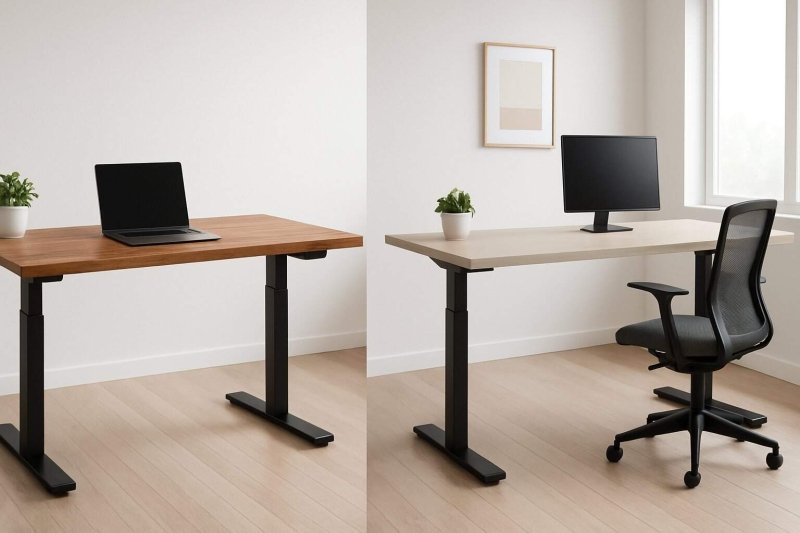
Solid Wood vs Composite Wood: Choosing Between Standing Desks
Dickson LamShare
With the increasing demand for standing desks, there's a corresponding surge in the variety of materials used to construct them. Two particularly popular choices in this landscape are solid wood and composite wood standing desks.
This comparison will help you gain a comprehensive understanding that will empower you to make an informed decision when selecting the ideal standing desk for your specific needs. Additionally, we will highlight extra benefits such as environmental impact and durability, providing you with valuable insights to make the right choice that aligns perfectly with your requirements and preferences.
Solid Wood vs Composite Wood: Quick Overview
|
Factor |
Solid Wood |
Composite Wood |
|---|---|---|
|
Appearance |
Natural beauty with unique grain patterns; timeless, elegant look |
Mimics natural wood; appearance varies by quality; can have uniform or varied grain patterns |
|
Durability |
Highly durable and sturdy; can last up to 15 years with proper care; prone to rot and scratches if not maintained |
Durable depending on type; high-density particle board is sturdy and scratch-resistant; MDF less durable and can swell with water |
|
Cost |
More expensive due to sourcing and processing large lumber slabs |
Generally more affordable; made from mixed wood fibers and resins or plastics |
|
Maintenance |
Requires regular cleaning and protection to prevent rot and damage |
Easier maintenance; resistant to warping and insect damage |
|
Sustainability |
Renewable and biodegradable; sourced from responsibly managed forests |
Made from wood fibers combined with adhesives and resins; less biodegradable; higher environmental footprint |
|
Resistance to Moisture |
Prone to moisture damage if not properly protected |
Enhanced resistance to moisture and insects due to composite materials |
|
Environmental Impact |
Lower footprint; supports reforestation and natural biodegradation |
Higher footprint due to adhesives and non-renewable materials in manufacturing |
Definition
In recent years, the rise of adjustable standing desks across Canada and the US has addressed the growing concern of a sedentary lifestyle that often accompanies office work. Understanding what is ergonomics helps explain why these desks have become essential for modern workspaces and why both materials are just as crucial in your choice of standing desk.
Solid wood is prized for its natural beauty, unique grain patterns, and robust construction. Popular wood species like walnut, acacia, cedar, and redwood are often chosen for their strength, texture, and timeless appeal. If you're considering this option, our guide on why you should choose solid wood for your next sit-stand desk offers valuable insights. Solid wood desks bring a sense of warmth and authenticity to any space, making them a favorite for those who appreciate the natural charm and character of real wood.
Composite materials, including wood plastic composites, MDF, and particle board, are engineered by combining wood fibers with resins or plastics. These composite woods are designed to mimic the appearance of natural wood while offering enhanced resistance to warping, moisture, and insects. Composite decking and composite wood desks are often more affordable and can be produced in a variety of colors and finishes, making them a versatile choice for many projects.
Appearance

When deciding between a composite standing desk and a solid wood standing desk, most shoppers tend to lean towards the aesthetics of solid wood. These solid wood boards are admired for their timeless, elegant appearance, infusing office spaces with a natural, inviting feel. What's more, real wood tabletops come in various varieties like walnut, acacia, and pheasantwood, offering buyers a unique range of grain patterns and colors to choose from.
High-quality composite desks can look very much alike to real wood, with varied grain patterns that make each board unique rather than uniform. We offer customers a selection of colors including oak wood, oak white, and oak black. For those interested in solid wood options, learn more about how to incorporate solid wood standing desks into a modern office design. Ultimately, the aesthetics of your standing desk's surface play a significant role in making your workspace a more inviting and productive place, and both solid and composite wood options offer distinct advantages to cater to your specific needs and style preferences.
Durability
One of the primary advantages of solid wood desks is their exceptional longevity. When they receive proper care, these desks can endure for generations. The innate density and strength of solid wood render it highly resistant to wear and tear, assuring that your investment remains robust and durable over time. In fact, when maintained correctly, our solid wood tabletops at EffyDesk can last for up to 15 years.
However, it's important to note that a poorly maintained desk can succumb to damages, particularly if exposed to excessive humidity or water. Solid wood is prone to issues like rot and scratches if not properly protected. To maintain the appearance and durability of your desk, regular cleaning and care routines are essential. For comprehensive guidance, check out our tips on how to clean and maintain solid wood office furniture. Maintaining and protecting the desk helps prevent rotting and surface damage, ensuring it stays sturdy and visually appealing for years.
On the other hand, composite wood options can also have a commendable lifespan, although it varies depending on the type of composite wood. For instance, medium-density fiberboard (MDF) is generally less durable than natural wood and can be susceptible to swelling when exposed to water. In contrast, the high-density particle board we use at EffyDesk is highly durable, features sturdy construction, and is resistant to scratches. When considering durability, it's also important to understand standing desk weight capacity and what you need to know about supporting your equipment safely.
Cost

Unlike composite wood, which can be manufactured from a diverse range of scrap materials and is readily produced or sourced, solid wood must be directly sourced from trees in the form of large slabs of lumber, which are less readily available than composite materials. This distinction significantly impacts the cost of production, with solid wood being notably more expensive than composite wood. The cost differential arises due to the extensive process involved in harvesting, selecting, and processing lumber from tree slabs.
For those with a flexible budget and a strong emphasis on environmental sustainability, investing in a solid wood standing desk not only delivers a sleek, high-quality workstation but also aligns with eco-conscious values by supporting responsible forestry practices and offering a biodegradable, renewable resource. To explore more sustainable options, learn about where you can find environmentally friendly furniture in Canada.
Sustainability
Solid wood is a standout option in terms of sustainability, as it is a renewable resource. Trees used in the production of solid wood can be replanted, ensuring a continuous supply for future generations. Moreover, solid wood tabletops are biodegradable, which means that when they eventually reach the end of their lifespan, they naturally decompose without leaving a lasting negative impact on the environment. This aspect of biodegradability makes solid wood a highly eco-friendly choice, aligning with environmentally-conscious values.
On the other hand, composite wood tabletops, while they offer their own set of advantages, do not carry the same environmental credentials as solid wood. Wood composites, such as particleboard and MDF, are made from a combined mix of wood fibers and other materials, including adhesives and resins. This manufacturing process impacts their sustainability, as some of the materials used may not be renewable or biodegradable. For example, wood-plastic composites are commonly used in decking materials and furniture, offering durability but often resulting in a higher environmental footprint compared to solid wood.
While composite wood can be a practical and cost-effective choice for those on a budget, it's essential to acknowledge the environmental trade-offs. The production process of composite materials often involves adhesives, chemicals, and the use of non-renewable resources. This results in a higher environmental footprint compared to solid wood, which is sourced from responsibly managed forests and can be continually regenerated through reforestation efforts. As the industry evolves, explore insights about the future of office furniture and sustainable designs that are shaping workspace solutions.
Conclusion
Solid wood desks offer unmatched natural beauty and long-lasting strength, while composite materials provide a practical, lower-cost alternative with enhanced resistance to moisture and wear. Other materials like metal and glass can add a modern touch or extra durability, depending on your preferences. For those seeking additional sustainable options, consider exploring bamboo standing desks for an eco-friendly office.
At EffyDesk, we understand the importance of offering a diverse selection of premium standing desks to cater to our customers' unique preferences. Our range includes composite and 100% real wood standing desks. Composite tabletops, a type of composite material, despite their visual resemblance to solid wood, are crafted by blending various hard and soft woods, which are then combined with resin to create a durable surface.